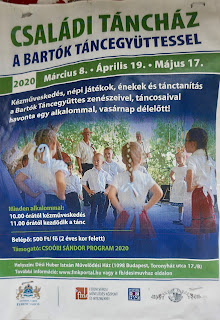The establishment of the Wekerle Estate took place before the First World War, when a man called Wekerle was Hungary's Prime Minister:
 |
| This statue of Wekerle stands in the central square of the Wekerle Estate. To my eye, there is something rather unsettling about the way he appears to be emerging out of the base |
Several architects were involved in the development of the Wekerle Estate, but the most prominent was Karoly Kos who was born in Timisoara and is responsible for, among other things, the lovely and eccentric Budapest Zoo. I suppose his style might be called Hungarian Secession or Transylvanian Art Nouveau.
 |
| Statue of Karoly Kos - I'm not sure if the sculptor was terrible or whether he actually looked as pained as that all the time |
It is slightly surprising that Kos is the only one of the architects involved to be commemorated. One of the others was convinced that, if you didn't have a garden, you must at least have a balcony, making him in my eyes a very good egg indeed, deserving of at least a bust, if not a full-length statue:
 |
| A balcony on a building in the Wekerle Estate |
I loved everything about the estate - the charming tendency to deviate from squares and oblongs:
the addition of towers and turrets because, well, why not:
the use of stone and timber wherever possible, giving a strong sense of the craftsman's hand at every turn:
The thousands of trees, creating the sense of a village, rather than the outskirt of a city:
The human scale of the place:
The estate is a really charming place, full of quirky, slightly arts and crafts, slightly fairytale buildings. I wonder if Lutyens would have liked the place, if he had known about it:
The architects' thoughtfulness for the needs of individual human beings - such a rare element in the work of so many architects - is evident everywhere. An example is this, which is not even as utilitarian a thing as a bus stop, just a nice sheltered bench, in case you feel like a quiet place to rest (strangely someone seems to have left a perfectly good pair of high heeled shoes there):
Having seen this on a noticeboard in the Wekerle estate:
I've decided to think the entire child population of the place devotes all its spare time to learning Hungarian dancing:
I've decided to think the entire child population of the place devotes all its spare time to learning Hungarian dancing:
I suppose the fact they have to advertise the activity on the community noticeboard may in fact mean that they need volunteers, but I prefer to retain my dream of an idyll where no child is staring into a screen and all are dashing home from school to get into their traditional costumes and get cracking on learning to master their national traditions.
Sadly, even in paradise, people lose their pets:






















No comments:
Post a Comment